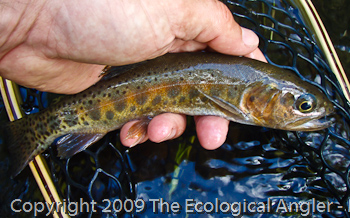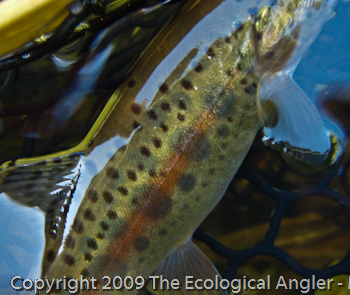Redband Habitat
Redband trout can be found in a variety of habitats depending on the age of the fish. Adults are generally found in areas of abundant cover associated with deep pools, dead trees, undercut banks, and overhanging vegetation. Juveniles are often found in shallow stream habitats. The redband trout is a spring (March through June) spawner with eggs usually hatching in four to seven weeks.
Catlow Valley Basin Redband

According to Behnke, several desiccated basins west of Alvord Basin and north of Lahontan Basin hold redband trout as their native trout species. One of those redband trout holding basins is the Catlow Valley Basin.

The redband is a unique subspecies adapted to the Catlow Valley Basin ecosystem. In these closed high desert basins, redband trout have evolved to survive in environments with vast extremes of both water flow and temperature.
According Behnke, Catlow Valley Basin redband are one of only eight separate desert basin populations of interior native redband trout.
Historic Distribution of Catlow Valley Basin Redband
Catlow Marsh has been broken into small, fragmented parcels near the outlets of tributary streams on the east side of the valley. Redband trout populations occupy three streams on the east side. These populations may still have fluvial or adfluvial life histories. However, several small irrigation diversions in the lower reaches of these streams may block passage. Population sampling in two of these creeks in 1993 revealed the redband numbers to be extremely low and far reduced from the abundances observed in the 1970s.
One stream on the west side of Catlow Vally is also home to native redband. This stream is naturally isolated from the rest of the system and has been since the desiccation of Catlow Lake some 10,000 years ago. This population also suffered from the 1992 drought based on observations by U.S. Fish and Wildlife Service staff at the Hart Mountain wildlife refuge.
